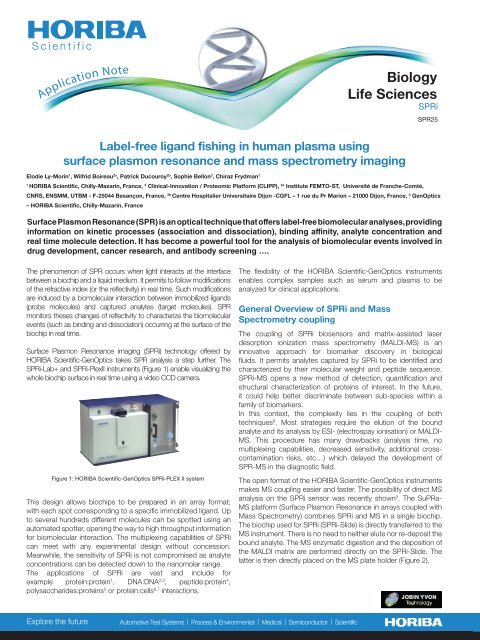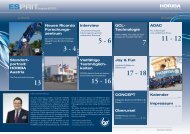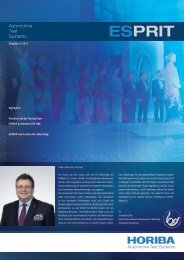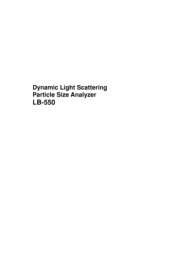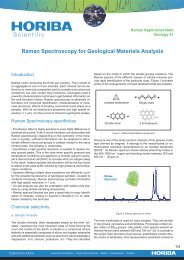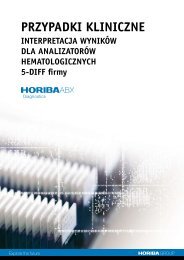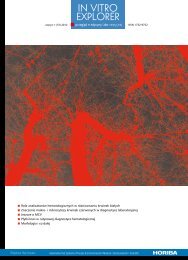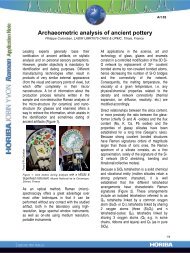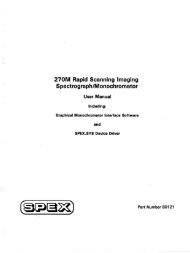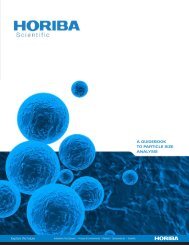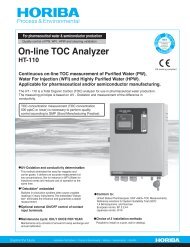Label-free ligand fishing in human plasma using - Horiba
Label-free ligand fishing in human plasma using - Horiba
Label-free ligand fishing in human plasma using - Horiba
Create successful ePaper yourself
Turn your PDF publications into a flip-book with our unique Google optimized e-Paper software.
Application Note<br />
<strong>Label</strong>-<strong>free</strong> <strong>ligand</strong> <strong>fish<strong>in</strong>g</strong> <strong>in</strong> <strong>human</strong> <strong>plasma</strong> us<strong>in</strong>g<br />
surface plasmon resonance and mass spectrometry imag<strong>in</strong>g<br />
Elodie Ly-Mor<strong>in</strong> 1 , Wilfrid Boireau 2a , Patrick Ducouroy 2b , Sophie Bellon 3 , Chiraz Frydman 1<br />
Surface Plasmon Resonance (SPR) is an optical technique that offers label-<strong>free</strong> biomolecular analyses, provid<strong>in</strong>g<br />
<strong>in</strong>formation on k<strong>in</strong>etic processes (association and dissociation), b<strong>in</strong>d<strong>in</strong>g aff<strong>in</strong>ity, analyte concentration and<br />
real time molecule detection. It has become a powerful tool for the analysis of biomolecular events <strong>in</strong>volved <strong>in</strong><br />
drug development, cancer research, and antibody screen<strong>in</strong>g ….<br />
The phenomenon of SPR occurs when light <strong>in</strong>teracts at the <strong>in</strong>terface<br />
between a biochip and a liquid medium. It permits to follow modifications<br />
of the refractive <strong>in</strong>dex (or the reflectivity) <strong>in</strong> real time. Such modifications<br />
are <strong>in</strong>duced by a biomolecular <strong>in</strong>teraction between immobilized <strong>ligand</strong>s<br />
(probe molecules) and captured analytes (target molecules). SPR<br />
monitors theses changes of reflectivity to characterize the biomolecular<br />
events (such as b<strong>in</strong>d<strong>in</strong>g and dissociation) occurr<strong>in</strong>g at the surface of the<br />
biochip <strong>in</strong> real time.<br />
Surface Plasmon Resonance imag<strong>in</strong>g (SPRi) technology offered by<br />
HORIBA Scientific-GenOptics takes SPR analysis a step further. The<br />
SPRi-Lab+ and SPRi-PlexII <strong>in</strong>struments (Figure 1) enable visualiz<strong>in</strong>g the<br />
whole biochip surface <strong>in</strong> real time us<strong>in</strong>g a video CCD camera.<br />
Figure 1: HORIBA Scientific-GenOptics SPRi-PLEX II system<br />
This design allows biochips to be prepared <strong>in</strong> an array format;<br />
with each spot correspond<strong>in</strong>g to a specific immobilized <strong>ligand</strong>. Up<br />
to several hundreds different molecules can be spotted us<strong>in</strong>g an<br />
automated spotter, open<strong>in</strong>g the way to high throughput <strong>in</strong>formation<br />
for biomolecular <strong>in</strong>teraction. The multiplex<strong>in</strong>g capabilities of SPRi<br />
can meet with any experimental design without concession.<br />
Meanwhile, the sensitivity of SPRi is not compromised as analyte<br />
concentrations can be detected down to the nanomolar range.<br />
The applications of SPRi are vast and <strong>in</strong>clude for<br />
example prote<strong>in</strong>:prote<strong>in</strong> 1 , DNA:DNA 2,3 , peptide:prote<strong>in</strong> 4 ,<br />
polysaccharides:prote<strong>in</strong>s 5 or prote<strong>in</strong>:cells 6,7 <strong>in</strong>teractions.<br />
The flexibility of the HORIBA Scientific-GenOptics <strong>in</strong>struments<br />
enables complex samples such as serum and <strong>plasma</strong> to be<br />
analyzed for cl<strong>in</strong>ical applications.<br />
General Overview of SPRi and Mass<br />
Spectrometry coupl<strong>in</strong>g<br />
The coupl<strong>in</strong>g of SPRi biosensors and matrix-assisted laser<br />
desorption ionization mass spectrometry (MALDI-MS) is an<br />
<strong>in</strong>novative approach for biomarker discovery <strong>in</strong> biological<br />
fluids. It permits analytes captured by SPRi to be identified and<br />
characterized by their molecular weight and peptide sequence.<br />
SPRi-MS opens a new method of detection, quantification and<br />
structural characterization of prote<strong>in</strong>s of <strong>in</strong>terest. In the future,<br />
it could help better discrim<strong>in</strong>ate between sub-species with<strong>in</strong> a<br />
family of biomarkers.<br />
In this context, the complexity lies <strong>in</strong> the coupl<strong>in</strong>g of both<br />
techniques 8 . Most strategies require the elution of the bound<br />
analyte and its analysis by ESI- (electrospay ionisation) or MALDI-<br />
MS. This procedure has many drawbacks (analysis time, no<br />
multiplex<strong>in</strong>g capabilities, decreased sensitivity, additional crosscontam<strong>in</strong>ation<br />
risks, etc…) which delayed the development of<br />
SPR-MS <strong>in</strong> the diagnostic field.<br />
The open format of the HORIBA Scientific-GenOptics <strong>in</strong>struments<br />
makes MS coupl<strong>in</strong>g easier and faster. The possibility of direct MS<br />
analysis on the SPRi sensor was recently shown 9 . The SuPRa-<br />
MS platform (Surface Plasmon Resonance <strong>in</strong> arrays coupled with<br />
Mass Spectrometry) comb<strong>in</strong>es SPRi and MS <strong>in</strong> a s<strong>in</strong>gle biochip.<br />
The biochip used for SPRi (SPRi-Slide) is directly transferred to the<br />
MS <strong>in</strong>strument. There is no need to neither elute nor re-deposit the<br />
bound analyte. The MS enzymatic digestion and the deposition of<br />
the MALDI matrix are performed directly on the SPRi-Slide. The<br />
latter is then directly placed on the MS plate holder (Figure 2).<br />
Explore the future Automotive Test Systems | Process & Environmental | Medical | Semiconductor | Scientific<br />
Biology<br />
Life Sciences<br />
1 HORIBA Scientific, Chilly-Mazar<strong>in</strong>, France, 2 Cl<strong>in</strong>ical-Innovation / Proteomic Platform (CLIPP), 2a Institute FEMTO-ST, Université de Franche-Comté,<br />
CNRS, ENSMM, UTBM - F-25044 Besançon, France, 2b Centre Hospitalier Universitaire Dijon -CGFL – 1 rue du Pr Marion – 21000 Dijon, France, 3 GenOptics<br />
– HORIBA Scientific, Chilly-Mazar<strong>in</strong>, France<br />
SPRi<br />
SPR25
Figure 2: The SuPRa-MS platform<br />
Biomarker Capture and Identification us<strong>in</strong>g the<br />
SuPRa-MS Platform<br />
A proof-of-concept study of SPRi-MS imag<strong>in</strong>g coupl<strong>in</strong>g was<br />
performed for the detection of LAG3 recomb<strong>in</strong>ant prote<strong>in</strong> <strong>in</strong><br />
<strong>plasma</strong>. The solution fraction of this prote<strong>in</strong> is a potential biomarker<br />
for breast cancer 10 . For this purpose, a mouse antibody (IgG2A)<br />
directed aga<strong>in</strong>st LAG3 was immobilized on a SPRi-Slide us<strong>in</strong>g a<br />
dedicated surface chemistry compatible with MS analysis (NHS<br />
chemistry). Before <strong>in</strong>ject<strong>in</strong>g LAG3, rat serum album<strong>in</strong> (RSA) was<br />
used to avoid non-specific b<strong>in</strong>d<strong>in</strong>g on the surface of the biochip.<br />
Then, the specific <strong>in</strong>teraction of LAG3 (added <strong>in</strong> <strong>plasma</strong>) and<br />
IgG2A was monitored us<strong>in</strong>g SPRi and images of the <strong>in</strong>teraction<br />
were studied. Several femtomoles/mm² of LAG3 prote<strong>in</strong>s were<br />
captured by SPRi. After direct process<strong>in</strong>g on the biochip surface<br />
(enzymatic digestion and matrix deposition), the SPRi-Slide was<br />
analyzed us<strong>in</strong>g a MALDI-MS imager (Ultraflex, Bruker Daltonics).<br />
By show<strong>in</strong>g the distribution of MS peaks specific of LAG3 and<br />
RSA respectively, it was possible to build the MS image of LAG3<br />
spots (Figure 3) directly on the SPRi-Slide.<br />
The SuPRa-MS platform pioneers the comb<strong>in</strong>ation of SPR<br />
imag<strong>in</strong>g and MS imag<strong>in</strong>g (MSi). It offers the possibility to ga<strong>in</strong><br />
spatially resolved <strong>in</strong>formation on the capture, sequence and<br />
molecular weight of cl<strong>in</strong>ical biomarkers.<br />
Figure 3: On-a-chip detection, identification and imag<strong>in</strong>g LAG3 prote<strong>in</strong> (potential<br />
marker of breast cancer) at 10 nM <strong>in</strong> <strong>human</strong> <strong>plasma</strong> through the SupRA-MS<br />
platform<br />
Conclusion<br />
Multiplexed SPRi analysis us<strong>in</strong>g the HORIBA Scientific-GenOptics<br />
<strong>in</strong>struments provides rapid and high-throughput <strong>in</strong>formation <strong>in</strong><br />
real time from up to several hundreds <strong>in</strong>teractions <strong>in</strong> parallel. The<br />
technology is sensitive and does not require the use of labels.<br />
It can speed-up the workflow and reduce consumable costs<br />
dur<strong>in</strong>g optimization processes. The coupl<strong>in</strong>g with MS analysis<br />
is straightforward and easier, which makes it a valuable tool for<br />
biomarker identification.<br />
References<br />
1. Uzun and al. (2009) Production of surface plasmon resonance<br />
based assay kit for hepatitis diagnosis. Biosensors and Bioelectronics.<br />
24(9): 2878-2884<br />
2. Spadavecchia and al. (2009) New cysteam<strong>in</strong>e based functionalization<br />
for biochip applications. Sensors and Actuators B.<br />
143(1):139-143<br />
3. Corne and al. (2008) SPR imag<strong>in</strong>g for label-<strong>free</strong> multiplexed<br />
analyses of DNA N-glycosylase <strong>in</strong>teractions with damaged DNA<br />
duplexes. Analyst. 133: 1036-1045<br />
4. Prieto and al. (2009) Synaptonemal complex assembly and<br />
H3K4Me3 demethylation determ<strong>in</strong>e DIDO3 localization <strong>in</strong> meiosis.<br />
Chromosoma. 118: 617-632<br />
5. Mercey and al. (2008) Polypyrrole oligosaccharide array and<br />
surface plasmon resonance imag<strong>in</strong>g for the measurement of glycosam<strong>in</strong>oglycan<br />
b<strong>in</strong>d<strong>in</strong>g <strong>in</strong>teractions. Anal. Chem. 80(9): 3476-<br />
3482<br />
6. Roupioz Y. and al. (2009). “Individual Blood-Cell Capture and<br />
2D Organization on Microarrays” Small 2009, 5, No. 13, 1493–<br />
1497<br />
7. Suraniti and al. (2007) Real-time detection of lymphocytes b<strong>in</strong>d<strong>in</strong>g<br />
on an antibody chip us<strong>in</strong>g SPR imag<strong>in</strong>g. Lab Chip. 7: 1206-<br />
1208<br />
8. Boireau and al. (2009) Revisited BIA-MS comb<strong>in</strong>ationb: Entire<br />
“on-a-chip” process<strong>in</strong>g lead<strong>in</strong>g to the prote<strong>in</strong>s identification at low<br />
femtomole to sub-femtomole leveks? Biosensors and Bioelectronics<br />
24: 1121-1127<br />
9. Bellon and al (2009) Hyphenation of Surface Plasmon Resonance<br />
Imag<strong>in</strong>g to Matrix-Assisted Laser Desorption Ionization<br />
Mass Spectrometry by On-Chip Mass Spectrometry and Tandem<br />
Mass Spectrometry Analysis. Anal. Chem. 81: 7695–7702<br />
10. Triebel and al (2006) A soluble lymphocyte activation gene-3<br />
(sLAG-3) prote<strong>in</strong> as a prognostic factor <strong>in</strong> <strong>human</strong> breast cancer<br />
express<strong>in</strong>g estrogen or progesterone receptors. Cancer Letters.<br />
235(1):147-53.<br />
Explore the future Automotive Test Systems | Process & Environmental | Medical | Semiconductor | Scientific<br />
2/2<br />
<strong>in</strong>fo.sci@horiba.com<br />
www.horiba.com/scientific<br />
USA: +1 732 494 8660 France: +33 (0)1 64 54 13 00 Germany: +49 (0)89 4623 17-0<br />
UK: +44 (0)20 8204 8142 Italy: +39 0 2 5760 3050 Japan: +81 (0)3 38618231<br />
Spa<strong>in</strong>: +34 91 490 23 34 Ch<strong>in</strong>a: +86 (0)10 8567 9966 Brazil : +55 11 5545 1540<br />
Other Countries: +33 (0)1 64 54 13 00<br />
This document is not contractually b<strong>in</strong>d<strong>in</strong>g under any circumstances - Pr<strong>in</strong>ted <strong>in</strong> France - ©HORIBA Job<strong>in</strong> Yvon 04/2011


